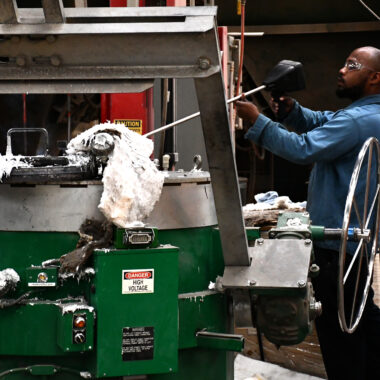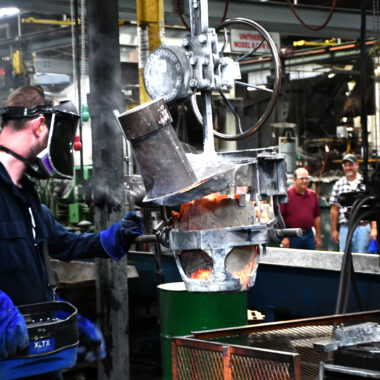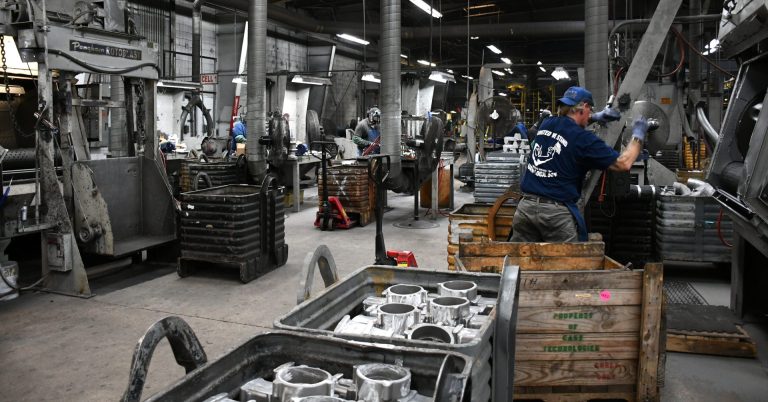About Aluminum Casting Basics: Every Little Thing You Need to Know
About Aluminum Casting Basics: Every Little Thing You Need to Know
Blog Article
Crafting Perfection: How to Accomplish High-Quality Aluminum Castings Every Time
In the realm of aluminum spreading, the search of perfection is a continual journey that requires a thorough method and an eager understanding of the ins and outs involved. Accomplishing consistent high-quality aluminum castings requires a thorough grasp of the procedures, from picking the appropriate alloy to implementing exact mold and mildew layouts and diligently regulating spreading specifications. However, the real proficiency exists in the capacity to implement these aspects effortlessly to produce flawless castings whenever. As we check out the complexities of crafting excellence in light weight aluminum castings, revealing the crucial approaches and techniques that lead to impressive results comes to be paramount for those pursuing excellence in this specialized area.
Understanding Light Weight Aluminum Spreading Procedures
Aluminum casting processes, important in the manufacturing sector, entail the intricate transformation of liquified light weight aluminum into strong types through a series of meticulously controlled actions. Recognizing these processes is vital to accomplishing top notch light weight aluminum spreadings continually - about aluminum casting. The key approaches used in aluminum spreading are pass away spreading, sand casting, and investment spreading

Each of these processes has its advantages and is selected based upon factors like intricacy, volume, and desired finish of the light weight aluminum casting. about aluminum casting. Comprehending the complexities of these techniques is important for makers aiming to create high-quality aluminum castings continually
Picking the Right Light Weight Aluminum Alloy
Choosing the proper light weight aluminum alloy is a vital choice in the manufacturing of high-quality light weight aluminum spreadings. When selecting an aluminum alloy for casting, it is essential to take into consideration the specific requirements of the application to make certain optimum efficiency.
One of the most generally made use of aluminum alloys for casting is A356 - about aluminum casting. For applications requiring high toughness, 7075 light weight aluminum alloy is a preferred choice due to its remarkable strength-to-weight proportion.
In addition to mechanical residential or commercial properties, considerations such as expense, accessibility, and post-casting procedures should likewise affect the option of the right aluminum alloy. By meticulously examining these elements, producers can guarantee the manufacturing of high-quality light weight aluminum castings that satisfy the preferred specifications.
Applying Correct Mold Style
Creating a reliable mold design is crucial for guaranteeing the successful production of premium light weight aluminum spreadings. Correct mold and mildew layout plays a considerable role in attaining the wanted explanation attributes of the last product. To execute an effective mold layout, variables such as product circulation, cooling down prices, and part geometry need to be very carefully taken into consideration.
One key facet of mold and mildew layout is making sure correct dental filling and solidification of the light weight aluminum within the mold tooth cavity. This entails developing jogger and gating systems that promote smooth metal flow and stop issues such as air entrapment or insufficient dental filling. Furthermore, including cooling networks right into the mold and mildew layout assists manage solidification prices and minimize the risk of porosity or shrinkage problems.

Controlling Casting Parameters

Ensuring Post-Casting High Quality Checks
To keep the excellent quality of light weight aluminum spreadings, comprehensive post-casting quality checks are essential. After the spreading procedure is finished, it is vital to make sure that the end products satisfy the wanted standards and requirements. Among the main quality checks involves examining the surface coating of the castings to recognize any issues such as porosity, fractures, or surface abnormalities. This visual examination is commonly supplemented by non-destructive screening techniques like ultrasonic screening or dye penetrant inspection to identify inner imperfections that may endanger the honesty of the spreading.
Dimensional precision is an additional vital facet that needs to be confirmed during post-casting quality checks. Dimensions of vital measurements and resistances ought to be taken to confirm that the spreadings satisfy the required specs. Furthermore, mechanical residential or commercial properties such as firmness, tensile toughness, and effect resistance might need to be examined through material screening to guarantee that the castings possess the required strength and resilience for their designated application.
Conclusion
To conclude, achieving high-quality aluminum spreadings needs a detailed understanding of the spreading processes, selecting the proper alloy, designing molds effectively, regulating casting specifications meticulously, and performing post-casting quality checks vigilantly. By adhering to these steps, producers can regularly generate aluminum castings that satisfy the greatest requirements of high quality and efficiency.
Attaining consistent top quality aluminum spreadings requires a comprehensive grasp of the processes, from picking the proper alloy to executing precise mold designs and thoroughly managing casting specifications. The primary approaches made use of in aluminum spreading are pass away spreading, sand casting, and financial investment spreading.
Investment casting, additionally why not check here known as accuracy casting, entails creating wax patterns that are covered in ceramic to create molds.Choosing the ideal aluminum alloy is a critical choice in the manufacturing of premium light weight aluminum castings.Making sure precise control over casting criteria is important for keeping uniformity and quality in aluminum spreading manufacturing.
Report this page